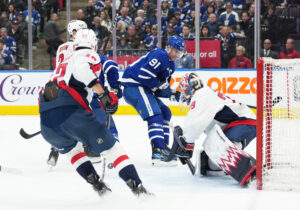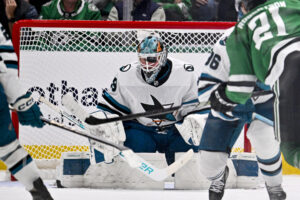Picking the Vancouver Canucks best players by jersey number gets easier as we go. Finally, into the teens, the options increase as we get players with spots nailed by training camp. Or ones who were the last to wear it. Either way – easy call!
Thing is, two of these guys have really interesting stories. So this list is kinda about them, with the other really good players mentioned in passing. Even then, we’ve made it as brief as possible. Or as reasonable, anyway.
The previous episode is right over here.
Vancouver Canucks Best by Number: 15-19
Today we’re starting with one of the best ever and ending it with a hockey-playing brother. It’s kind of a theme with the Canucks.
19 – Markus Näslund
How could this happen? The Canucks got a player who ended his Vancouver career all over the record books. Top ten in games played, top two in goals scored, top five in assists, ten hat tricks and two four-goal games. Three-time first-team All-Star and a Ted Lindsay Award. Captain for seven seasons and alternate for two. His number retired by the team. All in exchange for Alek Stojanov.
Looking back, it is easily the most lopsided trade in Vancouver’s history.
Okay, So How
But it wasn’t as bad as it looked then. It was surprising, but at least you could see the reasoning behind the move. Stojanov was a big, tough kid who the Canucks picked seventh overall in 1994 for a reason. His OHL scoring numbers were absolutely solid, and while his AHL numbers weren’t great, he was a feared enforcer.
The Pittsburgh Penguins didn’t need more scoring right away but did want toughness. They could wait for him to develop his NHL scoring touch, so long as he could defend their high-point guys and not look completely lost on the ice. Markus Näslund was homesick and frankly a bit depressed seeing who he was lined up behind.
Luc Robitaille and Kevin Stevens had finally moved on, but then the team brought in young hotshot Petr Nedvěd! He was thinking of going back to Sweden where they respected his ability. As far as Pittsburgh’s management was concerned, Näslund’s scoring was up, but that attitude had to go.
On the other side, Vancouver wasn’t a great team but a decent one. They had been to the Stanley Cup Final a couple of years earlier and had just lost scoring ace Pavel Bure to injury. Getting a scoring boost was needed. Including Stojanov, the team had six 100+ penalty-minute men after all, surely they could spare one. A deal was made, one-for-one.
What Happened Next
Näslund became everything he was for the Canucks only after spending two seasons in the bottom six. He wasn’t an instant hit, but by year three he was on the top line. In his fifth full year with the Canucks, he was hitting a point per game and was named captain. He was the 19th player to wear 19 for Vancouver – including Nedvěd – and it’s a fine coincidence that he’ll be the last.
18 – Igor Larionov
There is an argument worth listening to for Darcy Rota taking this one. He played more games with Vancouver, had more overall points, and was on Vancouver’s top line for a few seasons. His stat line of 120 goals and 236 points in 289 games is rock solid. So why did we go with Igor Larionov?
Partly, it’s because The Professor was part of the wave of Soviet Union players finally allowed to come to the NHL. He didn’t come over until he was 29 because the Soviet Union didn’t want to lose younger talent. So there was plenty of risk in drafting Soviet players, but the rumours were in place.
The Canucks drafted two-thirds of the famous KLM line late in 1985 and 1986, getting Larionov and Vladimir Krutov in the 11th and 12th rounds. Both came to the team for the 1989-90 season, and Larionov stuck when Krutov decided one season away from home was enough.
So if he’s the Canucks best to wear number 18, why was he only in town for three seasons? A simple, if unfortunate, reason: his handlers.
Why He Left
It was tough getting players out of the Soviet Union, even as glasnost took hold. Deals had to be reached with different groups in a former (but still kinda) totalitarian dictatorship. One of those groups was the Central Red Army, Larionov’s former team.
Another was Sovietintersport, the governing body of all sports in the Soviet Union. The deal reached with Sovietintersport was that they would be paid the equivalent of any player’s contract for as long as that player was with the team.
Larionov hated both groups with a passion, as they were stopping players from joining any other leagues. When he signed with Vancouver, he told the team he wouldn’t re-sign unless they could get out of that deal. He wanted NO money going back to his former league.
The Canucks couldn’t negotiate their way out of the deal, so Larionov went to Switzerland for a year. That broke the contractual continuity, plus he was now a free agent at age 33. Even without paying twice as much, how many years could he have left in him? The Canucks chose not to bid for his services.
Oops
Ten. Ten more years, Larionov played in the NHL. His nickname was well-earned, playing an incredibly smart game that stood him as a legitimate rival to Wayne Gretzky. His NHL numbers are nothing like Gretzky’s, of course, but his Hall of Fame induction was for his international play as well.
Larionov won two Olympic gold medals and one bronze, four World Championship gold medals, a silver and one bronze, two World Junior gold medals and a Canada Cup championship. In the NHL, he also won three Stanley Cups with the Detroit Red Wings.
For Vancouver, he played 210 games with 51 goals and 143 points, but most importantly he helped mentor Pavel Bure. Without Larionov there, it’s hard to say how well the Russian Rocket would have adapted to North America as a rookie.
17 – Ryan Kesler
The Canucks best ever number 17 is the only Canuck to win the Frank J. Selke Trophy. Not a hard choice, this one. Sure, Ryan Kesler didn’t leave under the best circumstances, but his decade with the team was excellent. His 655 games included 182 goals, 393 points and all the worst shifts.
Driving opponents insane was a gleeful habit, and his breakout season of 41 goals helped propel Vancouver to the President’s Trophy in 2010-11. The team couldn’t quite finish their Stanley Cup run, but his effort was never in doubt.
16 – Trevor Linden
Taken second overall in 1988 and with no regrets. “Captain Canuck” Trevor Linden was the first to pass 1,000 games and 300 goals with the team. Always turned it up when it mattered, with 34 playoff goals and 95 points in 118 games, FAR higher than his season averages.
Not only the Canucks best in number 16, he’s also the reason only 11 players have worn it. No other player touched it after he was traded away, and no one will after he came back to finish his career.
15 – Rich Sutter
There was a time when if you wanted to win hockey games, you needed a Sutter. It explains why Rich Sutter – not the most talented Sutter, but just as surly as the rest – played for seven teams in 14 seasons.
Rich played 291 games in a Canucks jersey, scoring 61 goals and 122 points and 533 penalty minutes over four seasons there. The penalty minutes certainly tell you he was raised with six brothers.
Not to throw shade on Rich, but this spot players try for a while and move on. Or coaches pick for players they’re trying out before they get moved on. In either case, Sutter is clearly the choice for the Canucks best at number 15.
Canucks Best by Number Coming Up!
Two more retired numbers, two incredibly irritating guys, and some tragedy.
Main Photo Credit: Bob Frid-USA TODAY Sports






